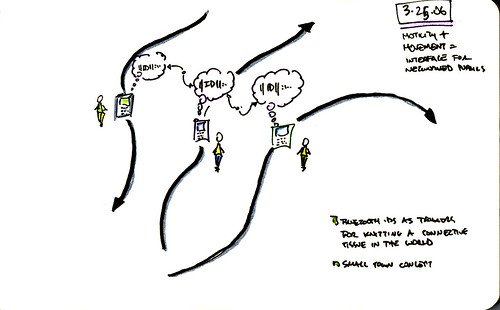I’m liking this Theory Object business more and more.
Why? Because it’s helping me think through design practices – it’s becoming a way to frame what I think many design and change agents do already, or how many design/change agents think already. It helps me realize that what I do is always imbricated in a knitted pattern or flow of practice-based “conversations” around a set of shared goals, hopes and desires about making things for near-future worlds.
Hopefully, it will also become a pedagogical trope that unlocks the general reticence some have of participating in these conversations, firstly, and then recognizing that making things can achieve the shared goals/hopes/desires by making things public.
Making things public is the counterpoint to the problem the poor, poor camel suffers under by being the brunt of the old design/architect joke about a camel being the result of designing a horse by committee. Oooh. There are so many problems with that joke nowadays. It’s not about a committee collectively designing one horse, it’s about a networked public collectively designing more habitable and sustainable worlds. One group may have an idea for a horse – so they go do that. Another group may say that they need something more camel-like to take care of the micro-local environmental concerns over in this part of the world. Yet another group may scratch their head and say, we have a surfeit of these darn pigeons..how can we enroll a gaggle of them in helping us better understand the micro-local context? (Pierre, yeah, sure, we could go talk to Boeing about getting a few truck loads of quarter sized sensors to sprinkle from the sky to gather micro-local contextual sensor readings, but..those Boeing Arphid things are made of icky plastic, gum up some important waterways, cause a problem when they blow over the highways, and don’t fly themselves back home so clean up is a real hassle, excepting pigeon poo, which we have to deal with _anyway_. That’s one of the reasons that the pigeons that blog theory object “works” – it explicates the really annoying assumption that the highly instrumentalized technical object makes sense.)
Making things public as a kind of approach to design practice is effective because the conversations that are of consequence circulate and raise design challenges of concern. Design challenges of concern are those that will yield more habitable worlds, worlds subject to the desires of social practices rather than business practices, worlds that have some hint of sustainability, worlds in which it is less likely that operational efficiencies that help one “make the quarterly numbers” drive research and development, etc. Networked publics such as those just now drooling out of the primordial ooze called the Internet are able to bring about worldly change by virtue of linking up their common concerns, sharing their ideas, their How To’s, their design documents, code nuggets, FAQs, calls for participation, sketches, prototypes, and next iterations. When I see that others in the public network are asking, answering, reframing and contesting the same questions, and designing for similar shared goals, I see hope for making things happen because I can see things happen.
I can understand, or empathize, with the design to not engage in the Theory Object business because it means that you have to engage in making things, and making those things public. It could be potentially embarassing. You may become deflated because you find out that someone else somewhere did the exact same thing you did and, for most of us humans, that’s a terrible ego blow. (“What? But my mom always said I was unique individual! If someone else is making ‘my’ thing, I must be a robotic clone..”)
Why do I blog this? It’s time to accept ourselves into the collective of networked public “making of things.” (Ew. That’s a horrid formulation. I’ll have to work on that.)
Technorati Tags: making things public, theory object
